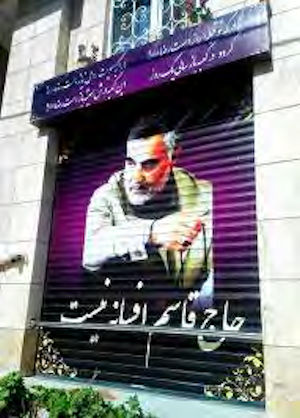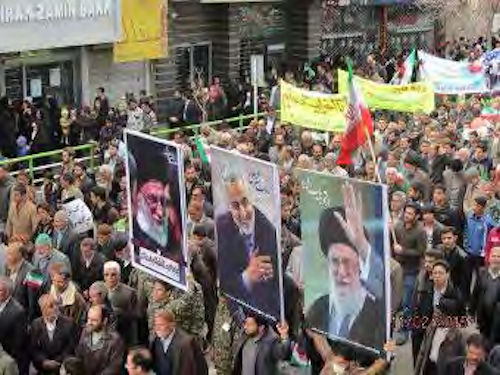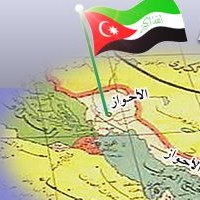![]()
Thursday, October 29, 2015 | By Dr. Raz Zimmt[1]
This study is originally published by The Meir Amit Intelligence and Terrorism Information Center. The study is structured in nine sections (see below), which if read in conjunction with each other, draws a complete picture of Major General Qasem Soleimani (Haj Qasem), commander of the Iranian Islamic Revolutionary Guards Corps’ Qods Force, instigator of Iranian Subversion and Terrorism in the Middle East and around the Globe.
Overview
For many years Qasem Soleimani was careful to keep a low media profile and was almost unknown to the Iranian public. However, as his media exposure increased, first in the Western and later also in the Iranian media, public support for him increased to the level of a personality cult.
Wave of support for Soleimani following the assassination attempt of the Saudi ambassador to the United States

A picture of Qasem Soleimani on the shutter of a store in the city of Karaj (Facebook, September 3, 2015)
The inclusion of Soleimani’s name in the affair of the attempted assassination of the Saudi ambassador to Washington in 2011 led to an unprecedented wave of support for him. It reached its height after deliberations in Congress where calls were heard for the assassination of senior Iranian officials, among them Soleimani. Two hundred and forty members of the Majlis signed a petition in support of Soleimani and warned the United States not to “continue its propaganda and plotting” against the IRGC (Dolat-e ma, November 2, 2011).
Conservative Iranian newspapers also rushed to express support for Soleimani. The daily Javan praised him in an article called “Who is Hajj Qasem Soleimani?” and described him as a man whose virtues exceeded his capabilities as a commander. According to the article, as opposed to claims raised in the Western media, Soleimani was not a mysterious figure but was well known in Iran because of his long years of service to the Islamic Revolution. Iran did not need the Hollywood stories the Americans tell about Soleimani and his activity outside Iran. His activities beyond the borders of Iran were only one side of the coin, and the other was his activity inside Iran as a soldier in the service of the regime. Since his appointment as commander of the Qods Force Soleimani had become “a nightmare” for the West, claimed the article, but among Iranians he inspired pride and was known for his calm, shyness, modesty and friendliness (Javan, November 5, 2011).
Ordinary Iranians were also enlisted to express support for the Qods Force. Bloggers and users of social media posted pictures of Soleimani captioned, “We are all Qasem Soleimani.” Public admiration for him was also expressed by the many sympathetic responses following the death of his mother in September 2013. Many Iranian social media users, some of them even identified as supporting the reformist opposition, expressed condolences and praised Soleimani for his great contribution to the security of the country.
Fostering Soleimani’s personality cult

A picture of Qasem Soleimani carried alongside pictures of the supreme leader at festivities for Islamic Revolution Day in Iran (Facebook page of Haj.Qasem.Soleimani, February 11, 2015)
Soleimani’s involvement in the campaign against ISIS, the successes attributed to him and his extensive media exposure, alongside the developments in Iraq and Syria in the summer of 2014, have led to an unprecedented wave of support. More than 20 Facebook pages are devoted to him with more than 100 thousand followers and dozens of pictures (including selfies) and videos documenting him, especially his visits to Iraq, which were posted on the social networks.
Popular support for him includes a biopic, a book of memoirs, a postage stamp, poems written in his honor and a YouTube video called “Iranian General” performed by The Nabz band.
As time passed, support for Soleimani began to turn into a personality cult. That led to reservations from the IRGC and Soleimani himself, if only for the sake of appearances. For example, he opposed having his picture posted on the social networks and had reservations about having a biopic made (Fararu, April 11, 2015).
In March 2015 Ramazan Sharif, the IRGC spokesman, made a media appeal to stop people from posting news about him during his visits to Iraq in order to keep information out of the hands of Iran’s enemies. He claimed Soleimani was displeased by his pictures in the media and social networks, and on several occasions asked they not be posted (Tabnak, March 12, 2015).

An Iranian TV show host wears a Soleimani T-shirt to mark his birthday (qasemsoleimani.ir, March 11, 2015)
It can be assumed that at least some of Soleimani’s traditional media and social network exposure has been deliberate. Its objective has probably been to advance his political aspirations and at the same time strengthen the image of Iran and the IRGC as the most influential deterrent factors in the Middle East, operating with determination against Iran’s enemies. In any event, Soleimani’s image has become the symbol of Iran’s regional might, and the Iranian regime clearly wants to magnify his image both at home and abroad.
![]()
You can find the introduction and other sections here:
- Introduction: Portrait of Qasem Soleimani, commander of the Iranian Islamic Revolutionary Guards Corps’ Qods Force
- Section 1: A short biography of Qasem Soleimani
- Section 2: Qasem Soleimani’s involvement in the Syrian civil war
- Section 3: Qasem Soleimani’s involvement in Iraq
- Section 4: Qasem Soleimani’s involvement in the Palestinian arena and Israel
- Section 5: Qasem Soleimani’s involvement in Lebanon
- Section 6: Qasem Soleimani’s involvement in Yemen and other Middle Eastern states
- Section 7: Qasem Soleimani’s involvement in internal Iranian politics
- Section 9: Possible lifting of international sanctions on Qasem Soleimani in the wake of the nuclear agreement
![]()
Notes:
[1] This study of Qasem Soleimani was written for the Intelligence and Terrorism Information Center (ITIC) by Dr. Raz Zimmt, a research fellow in the Alliance Center for Iranian Studies in Tel Aviv University and a research fellow at the Forum for Regional Thinking. His fields of expertise include the politics, society, foreign policy and social networks in the Islamic Republic. The study was coordinated with ITIC research fellows and includes information previously appearing in ITIC publications about the Qods Force.



 RSS
RSS












Latest Comments
Hello Mike, Thank you for your positive feedback to the article. I felt there wasn’t too much critical analysis of ...
Thanks for this considered and well constructed article. A follow up article on the manner in which the editorial contro...
THE CLUELESSNESS OF CLAIMING THAT OBAMA'S MIDDLE EAST POLICIES WERE A FAILURE CANNOT BE FURTHER FROM THE TRUTH, WHAT THE...
As long as Obama is the president of the usa do not trust the us government......
Thank you for an good read....